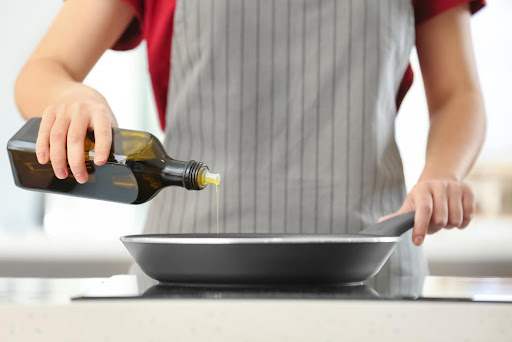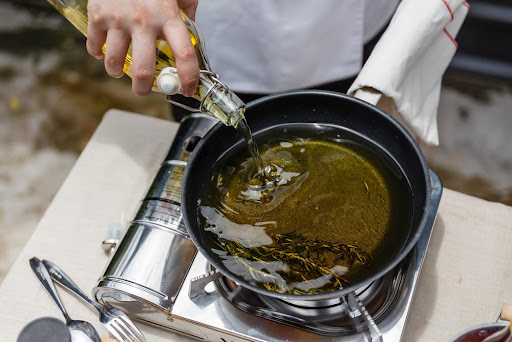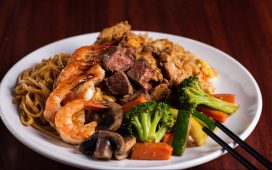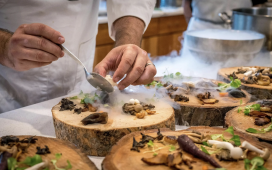Table Of Contents
Picture this – you’re at the grocery store looking for the perfect oil to cook your dish of the day with. Of course, it’ll require some frying, so what do you reach for? The cheap vegetable oil that your mom told you about, or the admittedly more expensive extra virgin olive oil?
The choice seems obvious, right? Well, maybe not.
It’s time to stop using vegetable oil for frying and start using something more versatile like one of the many Italian olive oils available in supermarkets and online. There are some benefits to using olive oil as a fryer that you might not know about. And, yes, there are also some precautions you must take before diving into this new frying technique of yours.
What Do We Mean by ‘Frying’?
A lot of people might be saying, “Oh, we already fry things in olive oil!” What you’re probably thinking of is sauteing. Let’s take a moment to discuss the differences just so we’re all on the same page.
Frying refers to cooking items by immersing them in hot fat, which in this case, is oil. You can have a shallow fry or a deep fry. A shallow fry is when the oil reaches about halfway up the food being cooked, and the food can touch the bottom of the pan it is cooking in. Deep frying is when there’s enough oil to completely submerge the food, and the food can actually float in the oil. Generally, when frying with olive oil, you’re going to aim for a shallow fry.
Sauteing is different, even though it still uses oil. In a saute, the oil is used to oil and cook ingredients cooked on a stovetop. Generally, more fat will be included in the cooking process. This is because you want to grease the pan so things don’t stick, not submerge your items in oil like frying. In this situation, the oil helps distribute heat throughout the foods to cook evenly and ensures nothing sticks to the pan.
Now, back to our original point. Can you fry with olive oil? Yes! Keep reading to find out tips and tricks on doing it safely.
Temperature Control
One of the things to remember when frying with extra virgin olive oil is that it has a much lower smoke point than other oils. A smoke point is a temperature at which oil begins to break down and smoke, which not only can affect the flavor of your dish but also pose a safety hazard.
Your typical vegetable oil has a smoke point of around 450 degrees Fahrenheit. Extra virgin olive oil has a smoke point of anywhere from 350 to 380 degrees Fahrenheit, depending on the kind of olives used to make it. That being said, frying with olive oil requires that you keep a close eye on temperature control. You’ll want to fry at lower temperatures than expected and well below the smoke point. Aim for 330 to 340 degrees Fahrenheit, as this is a good range for both the oil and the food to cook evenly without burning, which is what you’re trying to avoid.
How do you know what temperature your oil is at? Simple – use a frying thermometer. And if you don’t have one, a candy thermometer will do as well. Keep in mind that when you add the food to the oil, it will bring the temperature down, so be sure to continue to monitor it the entire time.
Take Your Time
Speaking of time, this is another crucial factor when frying with olive oil. You never want to heat it too quickly. This risks burning the oil, imparting a not-so-fantastic flavor to any food cooked in it. So take things slow. Let the oil heat up at a medium temperature. This may take longer, but it will be worth it. Good things come to those who wait! In this case, that good thing is going to be delicious food.
What Kind of Olive Oil to Use
Olive oil is produced worldwide, but most of it comes from Mediterranean countries, thanks to their ideal olive-growing climates. You can use any type of olive oil when frying, but choose extra virgin olive oil for the best results. It will have more flavor and nutrients than other types, which you want when cooking delicious food with it.
We’re a big fan of Italian organic olive oils with hints of herb and Spanish olive oils that impart nutty and fruity notes. Think about what you’re cooking and what flavors you want to enhance or add to the dish. Don’t be afraid to purchase a few different bottles to see which flavor profiles you like best.
What’s Best to Cook
As we mentioned, shallow frying is the best approach for olive oil, and for this reason, we think smaller, more bite-sized foods will cook well with this method. That means you should be thinking about seafood, a Mediterranean favorite, or smaller cuts of meat like chicken tenders. Items like squid rings or shrimp coated in crispy bread crumbs will cook nicely and be absolutely delicious. Avoid larger items like whole fish, bone-in chicken breasts and legs or pork chops. While these can also be fried with olive oil, it’s much harder to keep the temperature even and ensure they’re cooked through properly for safe eating.
Health Benefits of Cooking with Olive Oil
While the flavor is impressive, there are other health-related advantages to cooking with olive oil as well. Olive oil is very high in polyphenols, potent antioxidants that are being researched for their health benefits. Olive oil is also rich in oleic acid, an omega-9 fatty acid. Research has shown that this type of healthy fat can help reduce the effects and impact of inflammation. If that’s not reason enough to add it into your daily routine, we don’t know what is.
Final Words of Advice
When cooking with olive oil, always remember to use a frying thermometer and never leave the stove if you’re using it for frying. You want to keep a close eye on things to ensure the food is cooked thoroughly and there’s no chance of the oil burning. It will take some practice, but you’ll soon get the hang of it and create mouth-watering dishes.








